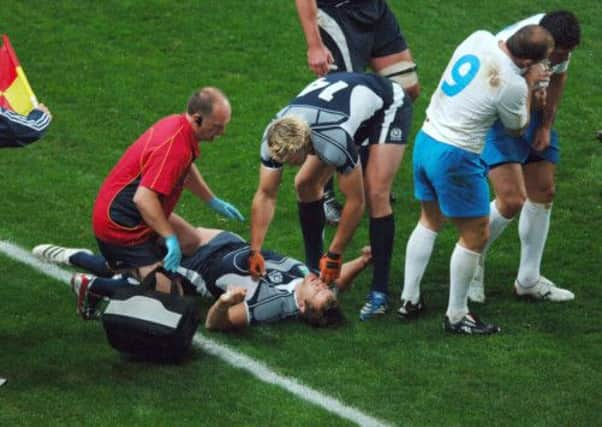Rugby must listen to concussion concerns


As the former Scotland full-back/winger and I discussed the expected reaction to his comments prior to publishing in last weekend’s Scotsman, where he revealed how players and coaches ignored concussion and injury, we acknowledged that the SRU’s track record did not point to an invitation to Murrayfield to discuss the points and study them in more detail to determine if they could learn from his experiences.
So, it came as no surprise when the SRU took great exception to the comments. They reacted as if stunned that any player might play with injury or hide symptoms and turned against Lamont, the whispering campaign that he has experienced for some years now, to the effect that he is nuts and “was never a team player”, being whipped up. The threat of legal action if such utterances about his career continued came as no surprise either.
Advertisement
Hide AdAdvertisement
Hide AdWhile Lamont and myself were studying the brain tissue of a prematurely dead boxer and rugby player in labs at Glasgow’s Southern General Hospital on Monday, and being shocked at the similarities, SRU’s top brass and current players were responding with suggestions that Lamont’s concern was not shared by anyone else in the game. Obvious, if flawed SRU tactic: isolate the germ.
Lamont probably did fret more than any player about his body, and was more reluctant than peers to play while injured, but to those shallow individuals who suggest it was down to a lack of courage – a player who underwent 16 operations, suffered over ten serious concussions and broke several bones through putting his body in the line – one glance at his medical records explains why.
A torn adductor at 18 led to two years of painful groin and pelvis issues that baffled doctors. Then, after insisting there was nothing to stop him playing, they diagnosed ‘Gilmore’s Groin’ and hernias, and told him his treatment had been flawed.
There followed good years injury-free and excellent quality of treatment for injuries, but also instances of playing with injury to impress a coach, as all players do, and ripped muscles, torn ligaments and broken bones that worsened because he tried to play through them, hid them or was told he was imagining them.
He trusted medics, he says, and praises Dr James Robson especially, but grew to trust himself more, and the point of his article was not to attack medics, as the SRU have taken it, as sports medicine is notoriously difficult, but to highlight the imprecise nature of it and urge players to stop and think before pushing through injuries, most notably concussion. A rugby-playing neuropathologist told him this week he was right to fear neurological issues later in life, and told me this is an issue that requires everyone in the game to open eyes to if players, far bigger, stronger, fitter and faster than their skeletons were created for, are to be protected.
The IRB said: “Lamont raises some very interesting points which highlight the need for everyone to pull together to ensure that players are appropriately educated about the risks.”
They defended the controversial Pitch Side Concussion Assessment (PSCA) with the oft-repeated statistic that it has led to a 25 per cent increase in the removal of players with concussion. Yet, within that is an admittance there were and remain players on the field with concussion. How many? In New Zealand, Dr Doug King witnessed the death of a club player in 1998 and ever since has been researching and leading advancements in concussion. He recently introduced gumshields that record data of head hits, revealing that, in the worst cases, players can sustain up to four times the strength of head knocks associated with car crashes.
He also brought in the King-Devick concussion test – the King behind that is no relation – in booklet form which players read after a game and quickly shows up concussion. It has proved effective in revealing concussion when medics and players did not realise a ‘knock’ had actually left some damage.
Advertisement
Hide AdAdvertisement
Hide AdJustin Wilson, coach of the Hutt Old Boys Marists, where the tests are taking place, said: “If you get a corked thigh [dead leg] it’s repairable, but we’re talking about guy’s heads. Doug has shown the club documentaries and what head injuries can do for the rest of your life and it’s really had an impact. This technology doesn’t give us an advantage over other teams, but it does in looking after our players.”
Eminently sensible, but the more evidence he finds the less enthusiastic the rugby authorities are to work with him. That is not uncommon in rugby, but, ironically, the SRU, through its medical chief Dr Robson, are doing more for players in leading the campaign to have concussion taken more seriously. Dr Robson does not, though, have influence over the defensive reaction of union officials. We and Lamont are still awaiting any invitation to discuss his concerns.
The IRB added: “The message remains the same to all in the game: if the player is clearly displaying concussion symptoms, sit him or her out. Don’t return.”
That is a crucial bottom line, but more evidence and education is required in what is a growing problem for rugby, and, in the interests of players, rugby’s officials have a duty to listen and embrace more openness.